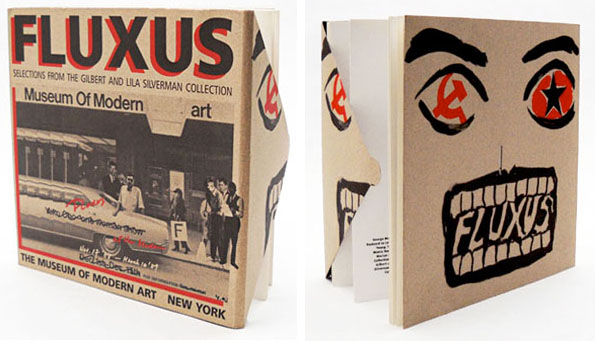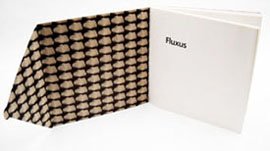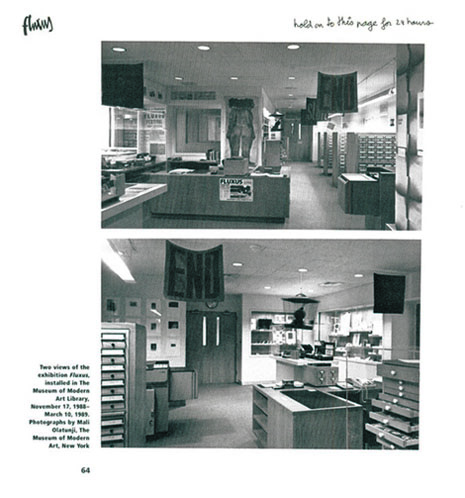Off the Shelf: Vintage Fluxus

From left: Front Cover: Yoko Ono. Montage incorporating photographic images of Rolf Jährling, Iain Macmillan, Nancy Mee, and Nori Sato. 1988. © 1988 by Yoko Ono. Back Cover: Milan Knizak. Drawing for catalogue cover. 1988. © 1988 by Milan Knizak.
During our intern walkthrough of the exhibition Staging Action: Performance in Photography since 1960, we learned about Yoko Ono and George Maciunas‘s Fluxus Wallpaper, which is displayed along the third-floor hallway at the entrance to Staging Action and Pictures by Women: A History of Modern Photography. I was surprised to see the wallpapered image exhibited, as I had recently come across it elsewhere: as the endpapers in Fluxus: Selections from the Gilbert and Lila Silverman Collection, the catalogue of MoMA’s first exhibition of the Silverman Fluxus Collection, in 1988. Interestingly, as is common with Fluxus, ideas and images circulated freely, and the version in the catalogue is another appropriation of Ono’s Film Number 4 (Bottoms) by Ben Vautier, titled Assholes Wallpaper.

Endpapers: Ben Vautier. Assholes Wallpaper. c. 1974.
Interactive, often humorous, text-based works characterize Fluxus art, and MoMA’s catalogue was clearly designed with the spirit of Fluxus in mind. The term Fluxus originated in 1961 as an idea by George Maciunas for the title of a magazine that would provide an overview of a “culture in flux” (a facsimile of Maciunas’s provisional plan for Fluxus‘s first six issues is reproduced in the catalogue). Fluxus 1 finally debuted in 1964 in an unusual format—it was mailed in a wooden box branded or stenciled with its title. Perhaps inspired by this package construction and subsequent others like it, MoMA’s Fluxus catalogue is bound in brown paper that folds over the back cover and closes like an envelope, compelling the reader to open it from the back. The front cover is a montage by Yoko Ono and the back cover is a specially commissioned drawing by Milan Knizak of a face whose barred teeth and open mouth spell “Fluxus.”

Page 64: Two views of the exhibition Fluxus installed in the MoMA Library. Photographs by Mali Olatunji. "Hold on to this page for 24 hours," line by Ben Vautier. Propositions for a Page. 1965–66, this version 1988.
Whether right side up, upside down, or perpendicular to the text, each page is annotated with instructions or questions to the reader called Propositions for a Page, by Ben Vautier (another rendition of a 1965–66 work). These directional lines instruct the reader to engage in a specific action: “Fold this page many times to the smallest possible size,” “Close your eyes while you look at this page,” and “Read this page through a mirror.” Writing in the catalogue, cocurator and former MoMA Library director Clive Phillpot states, “When scores and other paraphernalia are encountered in an exhibition, rather than activated and experienced through events, a vital dimension of Fluxus is missing.” He is obviously keenly aware of making exhibition materials reflect the experiential aspects of Fluxus. And Fluxus does just that.
